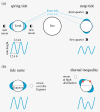Marine biorhythms: bridging chronobiology and ecology
- PMID: 28993497
- PMCID: PMC5647280
- DOI: 10.1098/rstb.2016.0253
Marine biorhythms: bridging chronobiology and ecology
Abstract
Marine organisms adapt to complex temporal environments that include daily, tidal, semi-lunar, lunar and seasonal cycles. However, our understanding of marine biological rhythms and their underlying molecular basis is mainly confined to a few model organisms in rather simplistic laboratory settings. Here, we use new empirical data and recent examples of marine biorhythms to highlight how field ecologists and laboratory chronobiologists can complement each other's efforts. First, with continuous tracking of intertidal shorebirds in the field, we reveal individual differences in tidal and circadian foraging rhythms. Second, we demonstrate that shorebird species that spend 8-10 months in tidal environments rarely maintain such tidal or circadian rhythms during breeding, likely because of other, more pertinent, temporally structured, local ecological pressures such as predation or social environment. Finally, we use examples of initial findings from invertebrates (arthropods and polychaete worms) that are being developed as model species to study the molecular bases of lunar-related rhythms. These examples indicate that canonical circadian clock genes (i.e. the homologous clock genes identified in many higher organisms) may not be involved in lunar/tidal phenotypes. Together, our results and the examples we describe emphasize that linking field and laboratory studies is likely to generate a better ecological appreciation of lunar-related rhythms in the wild.This article is part of the themed issue 'Wild clocks: integrating chronobiology and ecology to understand timekeeping in free-living animals'.
Keywords: circadian; invertebrates; lunar; molecular; shorebirds; tidal.
© 2017 The Authors.
Conflict of interest statement
We have no competing interests.
Figures




References
-
- Alerstam T. 1990. Bird migration. Cambridge, UK: Cambridge University Press.
-
- Dunlap J. 2004. Chronobiology. Sunderland, MA: Sinauer Associates.
-
- Naylor E. 2010. Chronobiology of marine organisms. Cambridge, UK: Cambridge University Press.
MeSH terms
Grants and funding
LinkOut - more resources
Full Text Sources
Other Literature Sources

